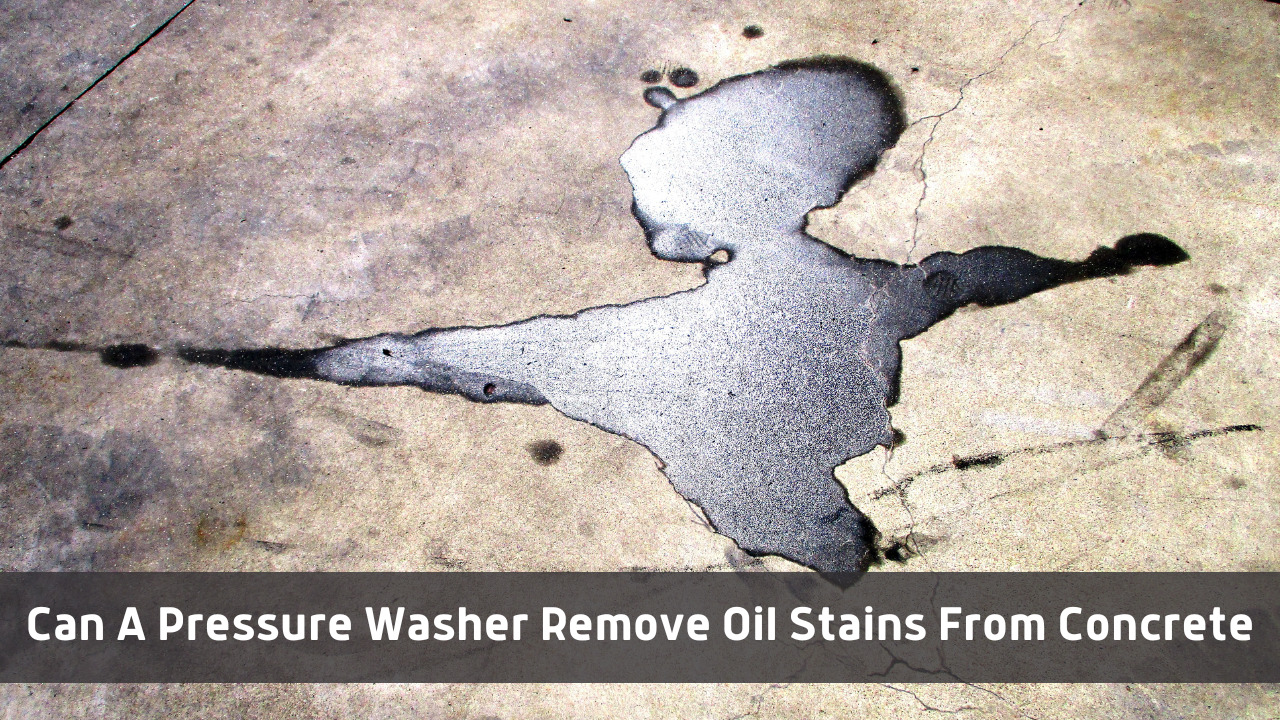Do you need to know how to use a pressure washer to remove oil stains from a driveway? Well, the work isn’t exactly taxing. This mess can be quickly cleaned up with the appropriate supplies and tools.
A power washer can rapidly and effectively remove oil stains from a concrete driveway. After removing any obvious oil stains, use a hot water pressure washer to remove any remaining oil that may have stained or pierced the concrete surface.
Thankfully, the task isn’t too difficult. This mess can be quickly cleaned up with the right supplies and equipment.
Table of Contents
Does Pressure Washing Suitably Remove Oil Stains From Concrete?
Oil stains can be harmful and unsightly, making them difficult to eliminate. Most of us will eventually have to deal with the stain created by an oil leak. Whatever method you choose to remove oil stains will take time and effort.
One of the finest ways to remove oil stains from the driveway is to power wash it. Power washers use hot water, which, as you are likely aware from dishwashing, easily removes oil and grease compared to cold water.
Oil stains on a concrete driveway can be removed quickly and easily using a power washer. After removing excess oil from visible oil puddles, rinse the concrete with hot water pressure washing to remove any remaining oil that has stained or penetrated the surface.
Utilizing the force of a medium-duty pressure washer, the oil stain driveway pressure cleaning operation will be finished swiftly. Cleaning the surface with detergent is necessary if you don’t have a powerful machine.
Steps To Pressure Wash Concrete To Remove Oil Stains
Pressure washers deliver a powerful, focused stream of water to remove dirt more effectively than a brush while using less water than a garden hose. A motorized hosepipe is what a pressure washer essentially is.
It employs a pump to produce a high-pressure jet of water that removes dirt more rapidly and efficiently than you can with a brush or hose alone.
Clean The Concrete Driveway
Remove any obstacles from your driveway. This might apply to any automobiles, furniture, or toys you have for your children. Then quickly sweep any debris, such as dirt and tiny stones, off your driveway with a large push or utility broom.
Use A Paper Towel For Soaking Up Oil
Apply a good amount of baking soda, corn starch, or cat litter to fresh oil stains to absorb them. These goods are easily accessible and reasonably priced; you may find them at your home or the hardware shop and market down the street.
First, pour a consistent amount over the extra oil. Spread it out evenly. The stains should disappear in about 30 minutes. Let the absorbent substance sit overnight for larger oil puddles.
Sweep Out The Debris
Sweep debris into a dustpan using a push broom to dispose of it, and scrubbing the last bit of surface stain after that is recommended. Concrete is still permeable, despite how hard it may seem to be.
Because of this, some of its tiny openings could still allow some oil to sneak in. If oil stains are allowed enough time to dry and harden, this will undoubtedly be visible—Determinately attempt to clean up any oil spills as soon as you notice them.
A thorough cleaning is necessary for partially dried spots on the concrete. Apply a liberal amount of degreaser solution to the troublesome area. Give the mixture a few minutes to let the stains come out.
After that, clean the stain with a firm nylon bristle brush in a circular motion. Clean off with water after sweeping away any remaining oil clumps. To moisten the driveway completely in preparation for applying detergent, you can also hose it off at this point.
Start Pressure Washing
The pressure washer should be set up. Simply put, hot water dissolves oil and grease at the molecular level, making it better to utilize a hot water pressure washer in this circumstance. Consider how much simpler washing dishes in hot water than cold is when they are greasy and unclean.
It will also function with a standard cold water pressure washer. Make a concrete cleaning solution. Some are designed specifically for pressure washers. You can pour detergent into a tank that some pressure washers feature for holding detergent.
Others will need a siphon hose to transfer the detergent from an outside source into the washing machine.
Cover The Concrete Surface With Detergent
Sweeping strokes are used to spray down the driveway. Maintain a distance between the wand and the concrete. Make sure to apply a detergent on all of the surfaces. Allow the detergent to perform its work of dislodging the oil, dirt, and grime that has penetrated the surface pores of the concrete for a couple of minutes.
Make sure the detergent doesn’t dry out.
Rinse Off The Detergent
Apply the same pattern for rinsing the driveway you initially did for applying the detergent. Spend a little longer sweeping the area until you reach the oil spots. The detergent-filled oil can thus be lifted from the concrete surface by pressure.
A similar effect might be achieved by bringing the wand closer to the surface.
Seal The Concrete After Washing
Hold off until the driveway’s concrete is entirely dry. Apply a concrete sealant to shield it from stains and bad weather conditions. Use a paint roller to accomplish this. Wait until the sealant has dried completely. You can also add one more coat of sealant if essential after a few minutes of drying the first coat.
Conclusion
Due to their stickiness, substances that resemble oil and grease are difficult to get off of concrete. However, a pressure washing machine can address this issue by removing filth from any surface. A concrete driveway frequently develops oil stains. They are an inconvenience, whether they are inside your garage or actually on your driveway.
If you have oil spills, wipe them up immediately; otherwise, they’ll spread and require extra cleaning time. The oil stains are quite simple to remove with a pressure washer. It is quick and affordable to complete.





